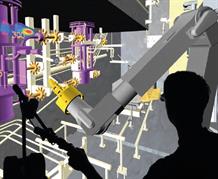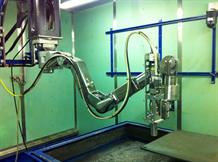R&D challenges on clean-up/dismantling
“Our developments cover all stages of the clean-up and dismantling process so as to achieve optimal performance levels” said Christine Georges, manager of R&D programme for clean-up and dismantling at the CEA Nuclear Energy Division (DEN). This R&D work firstly concerns assessing the radiological state of the facilities, from the start of the work then throughout all the operations. This means locating hot spots, identifying radioelements and estimating the physical and radiological activity of materials so that they can be sorted according to their categories. This task is far from easy, as the architects’ drawings of facilities built in the 1960s are not always as accurate as nowadays, like omitting the lines of some pipes that must be taken into account at all costs. Likewise, there may be some uncertainties on the state of some radioactive substances contained in the tanks for dozens of years, thus delaying the start of operations, which cannot commence without an overall characterisation.
Innovative technologies for quantifying radioactivity remotely
To deal with these unforeseen situations, the CEA’s researchers have had to be innovative. This has led to the development of the ‘gamma camera’ technology which can identify, locate and quantify hot spots in inaccessible areas, a major issue for establishing the plan of dismantling operations.
Five categories of radioactive waste
There are five main categories of radioactive waste, depending on their level of radioactivity and their lifespan:
- VLLW, very-low-level waste (27 % of the volume of radioactive waste produced in France);
- LILW-SL, short-lived, low- and intermediate-level waste (63 % of this volume);
- LLW–LL, long-lived, low-level waste (7 %);
- ILW–LL, long-lived, intermediate-level waste (3 %);
- HLW-LL, long-lived, high-level waste, which represents 96 % of the total radioactivity of the waste but only 0.2 % of the volume.
The vast majority of the waste generated by a dismantling worksite is VLLW. For example, the waste from the INBs at the CEA Grenoble centre produced 96.1 % of VLLW, 3.7 % of LLW, 0.1 % of ILW and 0.03 % of HLW.

Simulation of a remotely controlled operation on a hot cell with the hot spots highlighted, in the ‘immersive room’ at Marcoule © CEA
The gamma camera’s principle involves amplifying gamma ray emissions by radioelements in the form of an electrical signal which is detected and converted into an image. The CEA proved capable of harnessing all of its expertise, from the detector design through to the expert use of the final system, to develop a sensitive, compact industrial version of this camera. The DEN’s engineers also developed a remote material analysis technology called Libs (Laser-Induced Breakdown Spectroscopy) in partnership with IVEA. Installed on a drone or controlled by an operator, its mechanism focuses a pulsed laser beam on the material to be analysed to create a plasma which, as it cools, emits light radiation characteristic of the material’s elements. An optical system coupled to a spectrometer then collects this light, analyses it and provides information on the fundamental composition. This new technology was also installed on board NASA’s Curiosity rover to determine the composition of the soil on Mars.
Choosing the most appropriate clean-up and dismantling scenario by simulating the worksite
Work cannot be started on a clean-up and dismantling site without a minimum amount of preparation. Modelling and numerical simulation are essential for this, both to validate a scenario and to train the operators for the work to be performed. In 2008, the CEA set up a virtual reality room at Marcoule, called the “immersive room”, equipped with a large videowall showing full-size simulations of operations so users can practise, in a virtual environment, all the operations to be performed.
For example, the CEA was contacted by the start-up company Oreka Sud which markets a 3D decision-support simulator giving a complete overview of a dismantling project. “The Demplus software can technically create several work scenarios and assess the associated main parameters: waste assessment, dosimetry assessment, estimation of the budget and planning. The DEN has provided us with feedback so we can incorporate field data and provide simulations that are as close as possible to reality” said Luc Ardellier, director of Oreka Sud. What is the advantage for the CEA? With this tool, the responses of industrial companies to the CEA’s invitations to tender can be standardised, thus making it easier to compare them in order to choose the most suitable tender for the requirements.
Cleaning up and dismantling with no exposure
“Our R&D also focuses on the radioactive decontamination of surfaces, the ground, etc. before dismantling and destruction” said Frédéric Charton, R&D project manager. This is how new chemical processes have come into being. They take the form of foams and gels containing active elements, which are injected into complex areas that are difficult to access, such as ventilation systems or storage tanks, and trap the radioelements in them, liquefying on contact. The liquids are then recovered and treated as effluents. This is referred to as the ‘transfer’ method for eliminating radioactivity. Researchers are also working on the development of mechanical and laser decontamination techniques. New remote control tools have also been designed by the CEA to simplify dismantling operations in hostile environments and to better protect workers. Robotic systems such as the Maestro arm, developed in partnership with Cybernetix and commissioned in 2015 at the Marcoule pilot unit (APM), “lengthen” the operator’s reach. The scientists at Saclay have also created DELIA, a platform for developing laser cutting processes which are performed either in air or immersed.

Maestro arm for carrying out remotely controlled cutting operations © J.Vasquez/OTND
Facilities for treating the resulting waste and effluents
All this work produces waste, in addition to that from the CEA’s past nuclear activities. Here again R&D comes into its own, to minimise the volume and toxicity of this waste, optimise its treatment and conditioning, and understand and demonstrate the long-term behaviour mechanisms involved, while ensuring that there will be a disposal solution for final waste packages at Andra. Facilities specially adapted for the type of waste have been developed, including the vitrification workshop which was built in 1978 to specifically treat high-level fission product solutions from Marcoule (AVM). Before it was closed in 2012, this workshop was used to vitrify decontamination rinsing effluents from the UP1 factory. Since 1966, on the same site, the liquid effluent treatment plant (STEL) has been used for bituminising (embedding in bitumen) intermediate- and low-level effluents from spent fuel treatment operations. This organic matrix does however have a drawback, as under the influence of radiation, bitumen changes by radiolysis and generates gaseous hydrogen in the storage facility. R&D programmes are also under way to confirm the safety cases which demonstrate that the behaviour of such packages can be controlled, in particular in view of their future disposal in deep geological repositories under controlled safety conditions. “The STEL has now become ‘STEMA’, replacing bitumen with a mineral matrix, cement" explained Thierry Advocat, head of the programme for the management of waste and material flows at the DEN. CEA researchers determined the optimum formula for physico-chemical compatibility between the waste and this new type of embedding and then assessed the ageing of the final product. Another technique has been developed for low-level organic effluents, which is to mineralise them by hydrothermal oxidation, subjecting them to supercritical temperature and pressure conditions so that the “metamorphosis” occurs.
Older waste, a legacy of the CEA’s past, occasionally has to be reconditioned. At Marcoule, this operation began in the early 2000s, on 60,000 legacy bituminised waste drums stored in pits and vaults. To date, 10,000 drums have already been repackaged and placed in multi-purpose interim storage facilities (IEP). The aim is to characterise them in order to ascertain their nature and the amount of fissile material they contain, before classifying them into categories for acceptance by Andra in view of their transfer to the Cigeo disposal facility. To do this, the CEA uses the same non-destructive analysis methods as those used for the radiological mapping of a worksite, and also destructive analyses such as nuclear measurement techniques for long-lived beta emitters.